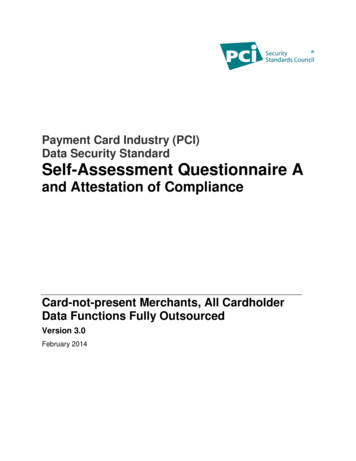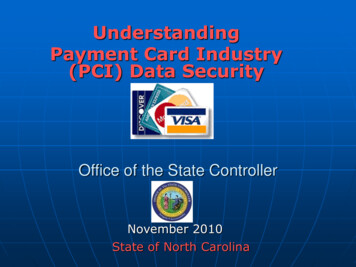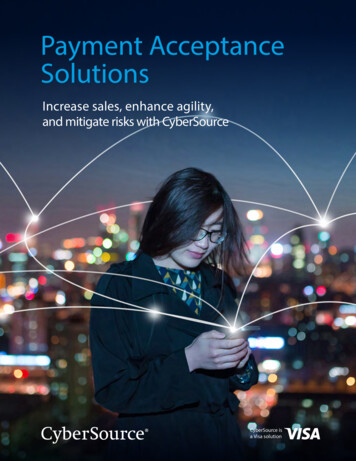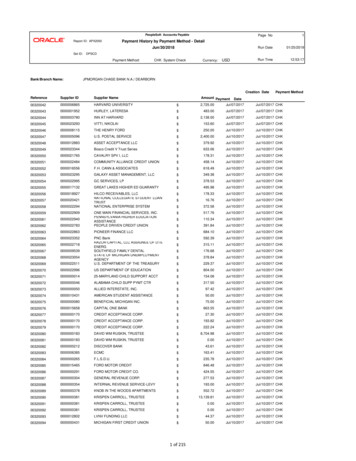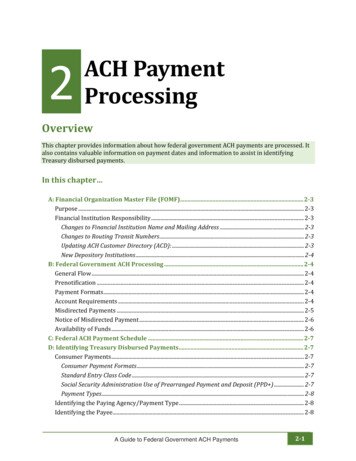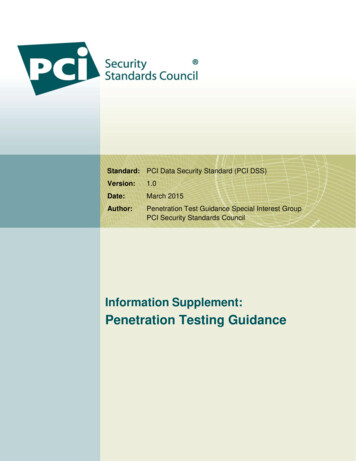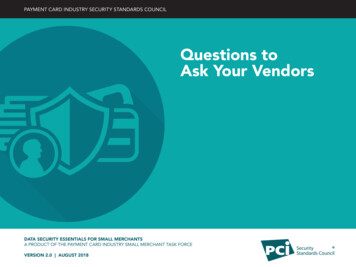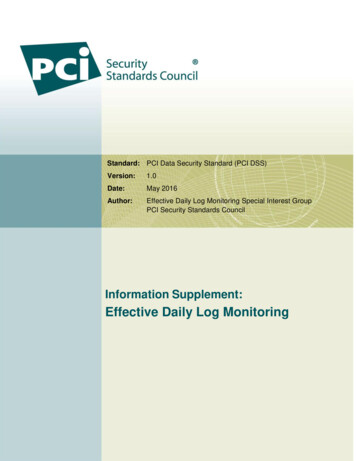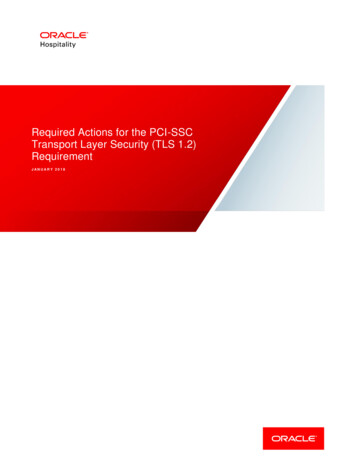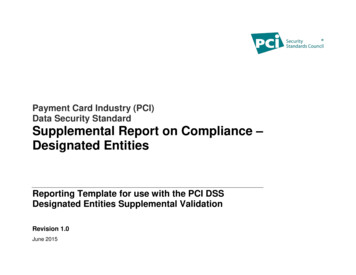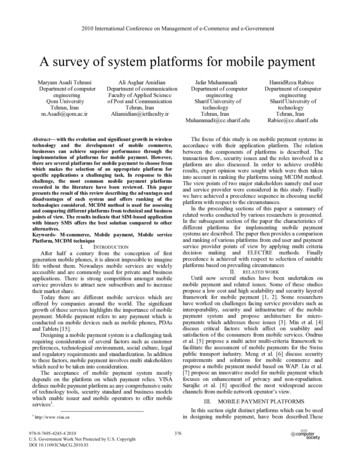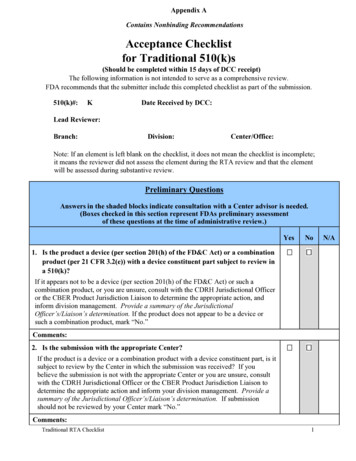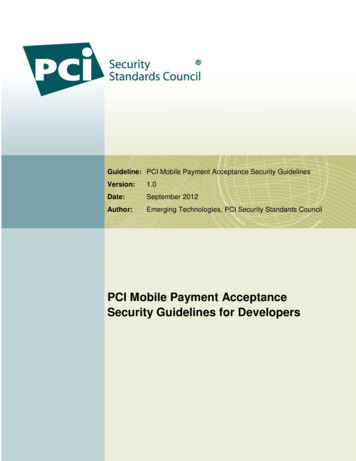
Transcription
Guideline: PCI Mobile Payment Acceptance Security GuidelinesVersion:1.0Date:September 2012Author:Emerging Technologies, PCI Security Standards CouncilPCI Mobile Payment AcceptanceSecurity Guidelines for Developers
PCI Mobile Payment Acceptance Security Guidelines September 2012Table of ContentsForeword . 21.Document Overview . 41.1Document Purpose and Scope . 41.2Security Risks of Mobile Devices . 42.Mobile Payments Guidance Overview. 63.Objectives and Guidance for the Security of a Payment Transaction . 7Objective 1: Prevent account data from being intercepted when entered into a mobile device. . 7Objective 2: Prevent account data from compromise while processed or stored within the mobile device. . 8Objective 3: Prevent account data from interception upon transmission out of the mobile device. . 84.1Prevent unauthorized logical device access. . 94.2Create server-side controls and report unauthorized access. . 94.3Prevent escalation of privileges. . 94.4Create the ability to remotely disable the payment application. .104.5Detect theft or loss. .104.6Harden supporting systems. .104.7Prefer online transactions. .104.8Conform to secure coding, engineering, and testing. .104.9Protect against known vulnerabilities. .114.10Protect the mobile device from unauthorized applications. .114.11Protect the mobile device from malware. .114.12Protect the mobile device from unauthorized attachments. .114.13Create instructional materials for implementation and use. .124.14Support secure merchant receipts. .124.15Provide an indication of secure state. .12Appendix A: Glossary .13Appendix B: Best Practices and Responsibilities.16Appendix C: Industry Documents and External References.18Appendix D: About the PCI Security Standards Council .19The intent of this document is to provide security risk-reduction recommendations. Information provided here does notaugment, replace or supersede requirements in the PCI Data Security Standard.1
PCI Mobile Payment Acceptance Security Guidelines September 2012ForewordThe PCI Security Standards Council (PCI SSC) is an open global forum for the ongoing development,enhancement, storage, dissemination, and implementation of security standards for account dataprotection. The rapid development of payment-acceptance propositions using mobile technologies has ledPCI SSC to consider its approach to provide guidance to secure all implementations.The PCI Security Standards Council charter provides a forum for collaboration across the payment spaceto develop security standards and guidance for the protection of payment card data wherever it may bestored, processed, or transmitted—regardless of the form factor or channel used for payment. All thisapplies only when a merchant, service provider, or other entity accepts payment card data from theircustomers. In other words, when individuals load their own primary account numbers (PAN) into their owndevices, the individuals are not required to validate their own devices to PCI standards. Other standardsbodies evaluate consumer protection for those scenarios. Conversely, when the same mobile device istransformed into a point of sale (POS) for a merchant to accept account data, there is the responsibility toprotect that information. Thus, PCI standards begin to apply when a mobile device is used for paymentcard acceptance.This document focuses on payment applications that operate on any consumer electronic handheld device(e.g., smartphone, tablet, or PDA) that is not solely dedicated to payment-acceptance transactionprocessing and where the electronic handheld device has access to clear-text data. For ease of reference,this subcategory is referred to as “Category 3, Scenario 2.” Separate PCI standards and documentationavailable on the PCI SSC website deal with all other categories and scenarios: Mobile Payment-Acceptance Applications and PA-DSS FAQs PCI PTS POI Modular Security Requirements, Version 3.1 (Category 1) PCI Payment Application Data Security Standard (PA-DSS), Version 2.0 (Category 2) Accepting Mobile Payments with a Smartphone or Tablet (Category 3, Scenario 1)In June 2011, PCI SSC agreed (see PA-DSS and Mobile Applications FAQs, 22 June 2011) that mobilepayment-acceptance applications that qualify as Category 3 will not be considered for PA-DSS validationuntil the development of appropriate standards to ensure that such applications are capable of supportinga merchant’s PCI DSS compliance. The PCI SSC recommends that mobile payment-acceptanceapplications that fit into Category 3 be developed using PA-DSS requirements and the guidance providedin this document as a baseline.The intent of this document is to provide security risk-reduction recommendations. Information provided here does notaugment, replace or supersede requirements in the PCI Data Security Standard.2
PCI Mobile Payment Acceptance Security Guidelines September 2012The purpose of this document is to raise awareness and to provide guidance to those in the best positionto protect the trust needed for a payment application that executes within mobile devices: the solutiondeveloper. This document encourages development of secure payment-acceptance solutions includingapplications using secure coding practices, and encourages both monitoring for advancements thatimprove integrity and preparing for newly discovered threats. While not exhaustive, this document outlinesa variety of both traditional and less conventional mechanisms to isolate account data and protect it fromexposure.DisclaimerPlease consider carefully the limitations of this document. In particular: No presumption should be made that meeting the guidelines and recommendations expressed inthis document would cause a solution to be compliant with PA-DSS. Entities wishing to use suchsolutions would need to make their own risk assessments around the use of such solutions inconsultation with their acquirers and applicable payment brands. Such solutions would be includedin an entity’s annual PCI DSS assessment to ensure that the application and its operatingenvironment are compliant with all applicable PCI DSS requirements. Due to its rapid evolution, payment brands may have differing approaches to mobile paymentacceptance. The guidelines and recommendations expressed in this document may not bythemselves be sufficient to meet the specific requirements of all payment brands or territories. Forexample, manual key entry on a merchant-owned consumer mobile device may be prohibited insome territories but permitted in others. For information and in the event of any doubt, pleasecontact your acquirer and/or the relevant payment brands/territories.The intent of this document is to provide security risk-reduction recommendations. Information provided here does notaugment, replace or supersede requirements in the PCI Data Security Standard.3
PCI Mobile Payment Acceptance Security Guidelines September 20121. Document Overview1.1 Document Purpose and ScopeThe Payment Card Industry Security Standards Council (PCI SSC) recognizes that merchants may useconsumer electronic handheld devices (e.g., smartphones, tablets, PDAs, or collectively, “mobile devices”)that are not solely dedicated to payment acceptance for transaction processing. For instance, a merchantmight use an off-the-shelf mobile device for both personal use and payment acceptance. Many of thesedevices have yet to incorporate generally accepted information security standards.The purpose of this document is to educate stakeholders responsible for the architecture, design, anddevelopment of mobile apps and their associated environment within a mobile device that merchants mightuse for payment acceptance. Developers and manufacturers can use these guidelines to help them designappropriate security controls within their software and hardware products. These controls can then beapplied to mobile payment-acceptance environments, thus supporting the deployment of more securesolutions.This document focuses on two areas: controls that may be currently satisfied by technology in today’senvironment, and controls meant to give guidance and direction for the design of mobile paymentacceptance apps and their associated environment within a mobile device. Where merchants’ mobiledevice hardware and software implementation cannot currently meet the guidelines documented herein,they may choose to implement a PCI-validated, point-to-point encryption (PCI P2PE) solution.Implementing such a solution would include the addition of a PCI-approved point-of-interaction (POI)device. With the use of a validated solution, account data is encrypted by the POI, and the mobile devicesimply acts as the conduit through which the encrypted payment transaction is transmitted.1.2 Security Risks of Mobile DevicesThis document defines mobile devices as consumer electronic handheld devices that are not solelydedicated to payment acceptance for transaction processing. These devices span a broad spectrum offeatures and functions ranging from cellular handsets that only support telephone functionality to“smartphones,” “tablets,” or “PDAs” that have a broader functionality.Any risk that exists on a standard desktop or laptop computer may also exist on a mobile device. Inaddition, mobile devices may have a broader set of functionalities than standard desktop and laptopcomputers, resulting in more security vulnerabilities. Along with the standard communication methods oftraditional desktop and laptop computers, mobile devices may also incorporate multiple cellulartechnologies (e.g., CDMA and GSM), GPS, Bluetooth, infrared (IR), and near-field communication (NFC)capabilities. Risk is further increased by removable media (e.g., SIM card and SD card), the internalelectronics used for testing by the manufacturer, embedded sensors (e.g., tilt or motion sensors, thermalsensors, pressure sensors, and light sensors), and biometric readers. Furthermore, vendor and networkoperator-level logging and debugging configurations may introduce additional risks.The intent of this document is to provide security risk-reduction recommendations. Information provided here does notaugment, replace or supersede requirements in the PCI Data Security Standard.4
PCI Mobile Payment Acceptance Security Guidelines September 2012Security risks are also inherent to the developmental life cycle and infrastructure associated with mobiledevices. The original equipment manufacturer, the operating-system software developer, the applicationdeveloper, the integrator, the reseller, the mobile-network operator (or cellular service provider), and themobile payment-acceptance solution provider each play a part in the overall security of a mobile device.Some developers are involved in multiple stages of the development process, making it potentially easierfor them to address more aspects of the device from the silicon layer to the applications running on theoperating system; other stakeholders are involved in only one stage of security development. Other thirdparties may introduce security risks through device drivers, mobile apps, peripheral equipment, andremovable media. All of these represent potential vectors for unauthorized access to device operations orunauthorized disclosure of account data. Deciding who is responsible for which best practice may beconfusing given the large number of contributors to the development of a mobile device. For more clarity,see the “Best Practices and Responsibilities” matrix in Appendix B.The intent of this document is to provide security risk-reduction recommendations. Information provided here does notaugment, replace or supersede requirements in the PCI Data Security Standard.5
PCI Mobile Payment Acceptance Security Guidelines September 20122. Mobile Payments Guidance OverviewThe cardholder data environment (CDE) is comprised of people, processes, and technology that store,process, or transmit cardholder data or sensitive authentication data, including any connected systemcomponents. This document does not focus on a PCI-validated P2PE solution, but on providing guidanceto reduce security risks in otherwise noncompliant mobile devices. For mobile payment acceptance, themobile device would be considered part of the CDE with full PCI DSS applicability unless used in tandemwith a PCI-validated P2PE solution (refer to the PCI AT-A-GLANCE Mobile Payment Acceptance Securitydocument entitled Accepting Mobile Payments with a Smartphone or Tablet) where the mobile devicewould act only as a “pass-through” for the encrypted data sent from the POI device.This document organizes the mobile payment-acceptance security guidelines into the following two sections: Section 3: Objectives and Guidance for the Security of a Payment TransactionThis section addresses the three main risks associated with mobile payment transactions: accountdata entering the device, account data residing in the device, and account data leaving the device. Section 4: Guidelines for the Risk and Controls in the Supporting EnvironmentIn addition to the guidelines specific to payment transactions, this section addresses securitymeasures that are essential to the integrity of the mobile platform and associated applicationenvironment.The intent of this document is to provide security risk-reduction recommendations. Information provided here does notaugment, replace or supersede requirements in the PCI Data Security Standard.6
PCI Mobile Payment Acceptance Security Guidelines September 20123. Objectives and Guidance for the Security of a PaymentTransactionThis section addresses the three main risks associated with mobile payment transactions: account dataentering the device, account data residing in the device, and account data leaving the device. An objectivewith associated guidance is given to address each of the three risks.Objective 1: Prevent account data from being intercepted when entered into amobile device.Guidance:Ensure account data is appropriately encrypted prior to entry into mobile device. This can beaccomplished via a validated PCI P2PE solution.1– OR –Ensure a trusted path2 exists between the data-entry mechanism (e.g., manual key entry or entry via acard reader) and the mobile device such that account data cannot be intercepted by an unauthorizedparty. One option to accomplish this is using a trusted execution environment that restricts accessbetween the mechanism receiving account data and secured memory located inside the device.If an external device is used for account data entry into the mobile device, that device should alsohave a means of demonstrating that it is authorized to communicate with the mobile device.If the external device is wireless (e.g., Wi-Fi or Bluetooth), the wireless communication channel shouldbe secured via strong cryptography.3Regardless of the process used, assure the account data entry channel is secured against client-sideinjections. Client-side injections include but are not limited to buffer overflows, data-type mismatches,embedded code or other unexpected data, and malicious or unauthorized apps and services on themobile device.Prevent the entry of PIN directly into the mobile device. If the system will permit PIN entry, it shouldonly occur through a PCI PTS-approved PIN entry device or EPP (encrypting PIN pad).123For more information, refer to AT-A-GLANCE Mobile Payment Acceptance Security document entitled Accepting MobilePayments with a Smartphone or Tablet available at www.pcisecuritystandards.org.See Appendix A for the definition of trusted path.See PCI DSS and PA-DSS Glossary of Terms, Abbreviations, and Acronyms for the definition of strong cryptography.The intent of this document is to provide security risk-reduction recommendations. Information provided here does notaugment, replace or supersede requirements in the PCI Data Security Standard.7
PCI Mobile Payment Acceptance Security Guidelines September 2012Objective 2: Prevent account data from compromise while processed or storedwithin the mobile device.Guidance:Ensure that account data is only processed inside a trusted execution environment. In order to preventdata leakage, account data should not be accessible outside a trusted execution environment. A dataleakage prevention methodology should be adopted based on industry best practices and guidelines.The methodology should include, but is not limited to: Secure distribution of account data Secure access to and storage of account data Controls over account data while in use (e.g., preventing copy/paste, screen shots, file sharing,and printing) Prevention of unintentional or side-channel data leakage4Temporary storage of account data prior to processing and authorization should be in a securedstorage environment, such as a secure element, to prevent third-party eavesdropping.If account data is stored on the mobile device post-authorization, that data should be renderedunreadable per PCI DSS Requirement 3.4. If encrypted account data is stored, any relatedcryptographic keys need to be managed in accordance with PCI DSS Requirement 3.5 so keys are notaccessible to unauthorized people, applications, and/or processes.Per PCI DSS Requirement 3.2, do not retain sensitive authentication data (SAD)5 after authorization.This includes ensuring that neither the mobile device nor any attached device retains SAD afterauthorization.Objective 3: Prevent account data from interception upon transmission out of themobile device.Guidance:Ensure that account data is encrypted (i.e., usi
The PCI Security Standards Council (PCI SSC) is an open global forum for the ongoing development, enhancement, storage, dissemination, and implementation of security standards for account data protection. The rapid development of payment-
